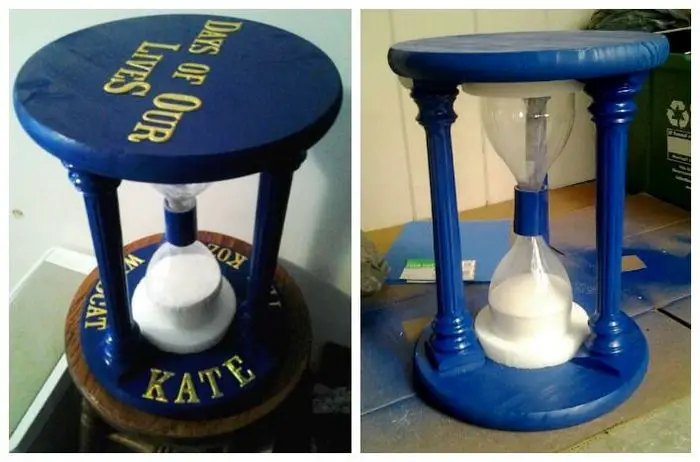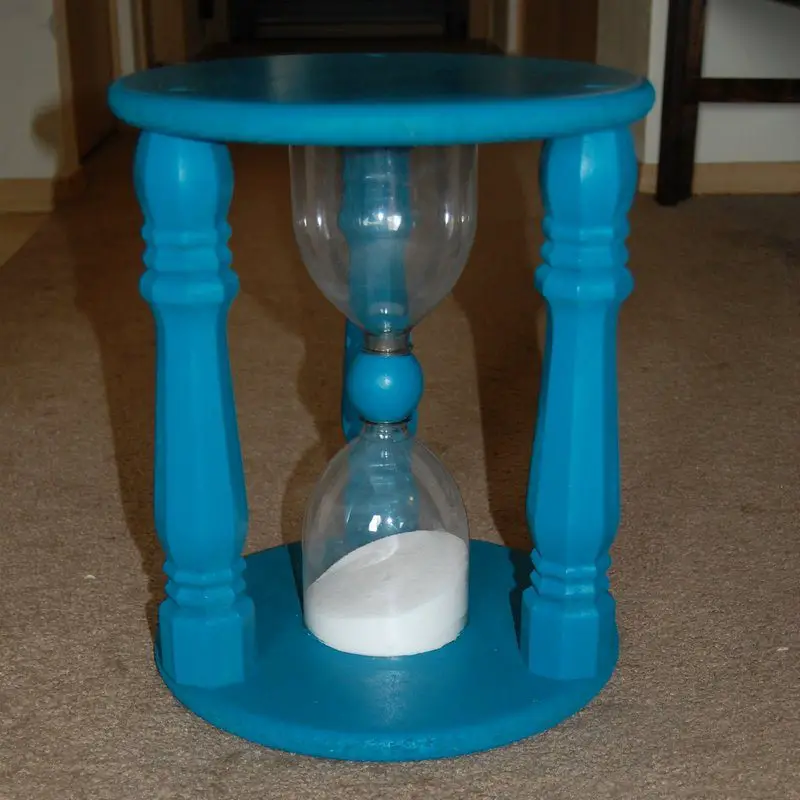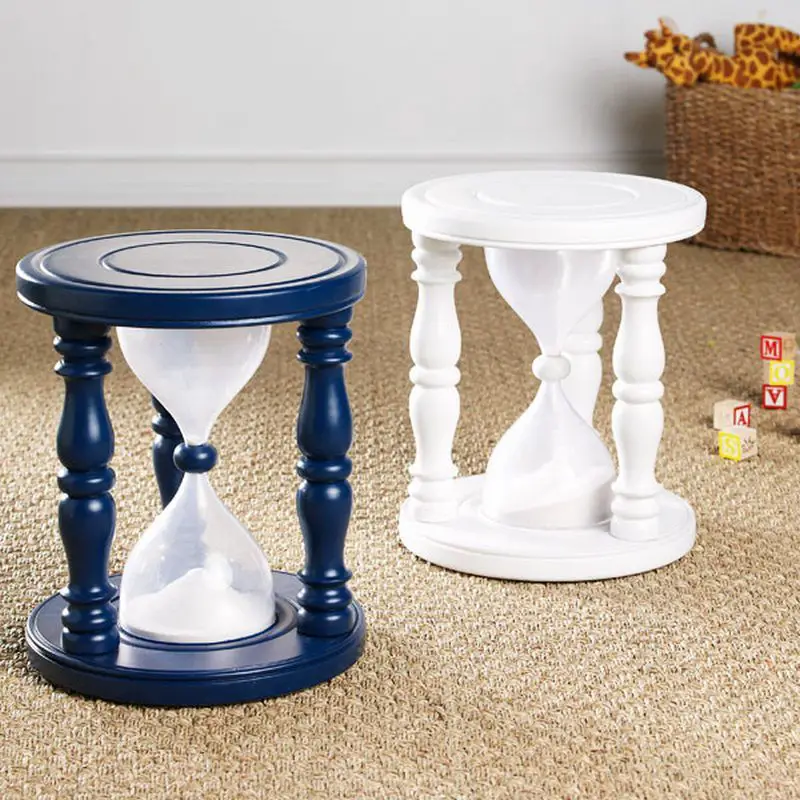Disciplining children is one of the most challenging parts of being a parent. As any parent knows, it’s a fine line between trying to teach them a behavioral lesson and making them feel that they’re being shamed. A sandglass time out stool is a decorative way of disciplining your kids.
We think it’s a much more positive approach than making a child go to their room or face the wall. You can tell them to behave quietly on the chair for, say, five or ten minutes, and you can properly discuss the matter at hand at the same time.

And as a bonus, it’s a great decorative furniture feature for the kids’ room or anywhere else in your home — a good weekend DIY project!
What do you think?
Contents
Building a Sandglass Time Out Stool
Materials
- 2 empty clear Soda Bottles
- 12″ Wood/MDF Circles
- 14″ Legs
- 2″ Wood Doll Head
- Spray Paint
- Washer
- Clear Silicone
- Sealant
- Clear Glossy Finish Spray Paint (optional)
- Pen/Marker
- White Sand/Salt
- E6000 Glue
Tools
- Router Bit
- Wood Clamps
- Drill
- Saw
- Measuring Tape
- Scissors
- Sander

Instructions
1. Prepare the stool
With the use of an MDF board, drill a small hole at the center of the wood doll head. Use a 1” drill bit. You can use the top of a soda bottle as a pattern. Sand out the inside to make it smooth and fit.
Using a router, we can create an indentation in the MDF circle to allow the soda bottle to sit snugly against the edges. You can skip this step if you don’t have a router, but it just ensures salt won’t leak.
2. Paint the MDF boards
To have beautifully painted wood, don’t forget to apply two coats.
You can also do a clear coat of spray paint or some polyurethane to give it a nice shiny finish.
3. Drill holes
Next, we predrilled holes for the screws so that the screws would go in straight and there would be less chance of the wood splitting.
To prevent the screw head from poking out of the circle, cut a cone-shaped piece out of the MDF. Ensure both circles have evenly distributed holes for the legs by putting the two circles together and drilling all the way through them.
In addition, we drilled holes at the top and bottom of the wooden legs so they would be properly screwed in.
4. Make the sandglass
To make the hourglass with the use of recycled plastic soda bottles, measure the height of the hourglass. Cut the soda bottles.
If you don’t want your sand timer to last too long, play with the length of the washer before gluing it on. You might want to drill a larger hole into the top of the washer to make sure you have the correct amount of sand in your timer and sufficient sand to make it aesthetically attractive.
5. Assemble them all together
Glue the washer onto the soda bottle top. You can add either sand or salt to the timer. In this project, we used salt to highlight the white color in the plastic soda bottle on the side without the washer. Now you can add the clear silicone to the soda bottle. Also, add it on the other side.
Attach the wooden doll head and both sides together. Ensure that all the corners are securely sealed to avoid the sand getting out. Then, add the wood filler on top of the concave screws. To flatten it, scrape the excess off with any card or similar object.
Finally, you have finished your DIY sandglass time out stool. You can have this used for your kid or it can be displayed in your living area.
The Psychology Behind Time-Out Stools
Disciplining children is a nuanced art that blends patience, understanding, and the right tools to guide behavior. Among these tools, the sandglass time out stool stands out as a particularly effective and empathetic method for teaching children about consequences, patience, and the passage of time.
This section delves into the psychological underpinnings of the sandglass time out stool, exploring how this innovative approach can foster better behavioral outcomes and emotional intelligence in children.
Visual Representation of Time
The sandglass time out stool offers a clear, visual representation of time, a concept that can be abstract and difficult for young children to grasp. Watching the sand trickle down provides a tangible sense of duration, helping children to connect the concept of time to their real-world experiences. This visual cue can make the wait during a time-out more bearable and understandable, reducing anxiety and promoting a sense of calm.
Encouraging Self-Regulation
Time-outs are fundamentally about teaching self-regulation, and the sandglass time out stool enhances this process by making the passage of time visible and tangible. Children learn to associate the emptying of the sandglass with the duration of their time-out, which can help them develop patience and control over their actions. This tool not only aids in managing behavior at the moment but also instills valuable life skills for managing emotions and reactions in the future.
Positive Approach to Discipline
Using a sandglass time out stool signifies a more positive approach to discipline. Instead of focusing on punishment, it emphasizes reflection and the opportunity to reset. The gentle nature of watching sand flow is less intimidating than traditional time-out methods, which can sometimes feel isolating or harsh. This positive reinforcement encourages children to view time-outs not as punishment, but as a chance to pause and reflect on their behavior.
Enhancing Time Awareness
Regular use of the sandglass time out stool can enhance a child’s awareness of time, helping them to better understand and manage it. This awareness is crucial for developing time management skills later in life. By learning early on that certain actions lead to a specific duration of time-out, children can begin to gauge the passage of time more accurately, aiding in their overall cognitive development.
Strengthening Emotional Intelligence
Time-outs can significantly develop a child’s emotional intelligence, especially when facilitated by a sandglass time out stool. By providing a quiet moment to reflect on emotions and actions, children learn to identify and express their feelings more constructively. This tool encourages a mindful emotional approach, fostering empathy, self-awareness, and better interpersonal relationships.
The sandglass time out stool is more than just a disciplinary tool; it catalyzes psychological growth and emotional learning. By integrating the concept of time with behavior management, it teaches children valuable lessons about patience, self-regulation, and emotional intelligence, setting the foundation for a more mindful and understanding approach to life’s challenges.
Click on any image to start the lightbox display. Use your Esc key to close the lightbox.









You can get full step-by-step instructions from Christine Peterson over at Christiney’s Crafts!
A Comparative Overview of Time Management Tools for Children
In parenting and education, time management is a critical skill children need to develop early on. Various tools and methods have been designed to help teach this concept effectively, each with its benefits and limitations. Among these, the sandglass time out stool has emerged as a unique and visually engaging option.
This section compares the sandglass time out stool with other time management tools for children. We highlight0 their features to help parents and educators choose the best options for their needs.
Sandglass Time Out Stool
The sandglass time out stool incorporates a visual and interactive element into time management and discipline. Unlike traditional methods, it provides a tangible representation of time passing, which is particularly effective for young children who may struggle with abstract concepts.
The gentle flow of sand can also have a calming effect, making the time-out experience less stressful and more constructive. The dual function of serving as both a disciplinary tool and a decorative item adds to its appeal. However, its effectiveness is primarily in settings where supervision is possible to ensure safety and proper use.
Digital Timers and Apps
Digital timers and applications offer a modern approach to time management with customizable settings for different tasks and activities. These tools can be very precise and may include features like alarms, countdowns, and even educational games to make learning about time fun.
While digital tools are versatile and portable, they may not provide the same level of engagement and physical interaction as the sandglass time out stool. Screen time considerations and the need for electronic devices may also limit their suitability for very young children.
Traditional Clocks and Watches
Teaching children to read traditional clocks and watches is fundamental to understanding time. This method emphasizes numerical literacy and time mechanics, laying a foundation for lifelong skills.
However, the abstract nature of clock faces and the concept of hours, minutes, and seconds can be challenging for younger children to grasp. Unlike the sandglass time out stool, traditional timepieces do not directly represent time elapsing, making them less effective for immediate time management needs, such as time-outs or short-duration tasks.
Visual Timers
Visual timers, similar to the sandglass time out stool, clearly indicate time passing through a visual medium. These might include electronic displays or mechanical devices that show a red disc disappearing as time elapses.
While these tools effectively demonstrate the passage of time, they lack the tactile and interactive qualities of the sandglass time out stool. Furthermore, visual timers often require batteries or electrical power, making them less environmentally friendly and potentially less convenient in terms of mobility and outdoor use.
Each time management tool for children has its strengths and areas where it might not fit. The sandglass time out stool stands out for its unique blend of visual appeal, interactivity, and educational value, particularly in teaching patience and time perception.
Choosing the right tool depends on the child’s specific needs and the context in which time management skills are being developed. For engaging young minds in the fundamentals of time, the sandglass time out stool offers a compelling, multifaceted, educational, and soothing approach.
Safety Considerations and Tips
Integrating a sandglass time out stool into your home or classroom to teach time management and discipline offers a creative and effective approach. However, ensuring the safety of children while using this unique piece of furniture is paramount.
This guide will outline essential safety considerations and tips to maximize the benefits of the sandglass time out stool while minimizing any potential risks.
Secure Construction
The construction integrity of the sandglass time out stool is paramount for its safe utilization in environments frequented by children. It is essential that every component, from the stool’s frame to the sandglass itself, is crafted from robust and resilient materials that can endure the rigors of daily use.
For the sandglass element, opting for high-grade, shatter-resistant materials is critical. This consideration ensures that, even in scenarios where the stool is accidentally knocked over or subjected to rough handling, the risk of the glass breaking and causing injury is minimized. Conducting regular inspections is a proactive step towards identifying and addressing any potential wear or damage.
This routine check helps in maintaining the stool’s prime condition, safeguarding its structural integrity and, by extension, the safety of the children using it. Look for signs of stress in the materials, loose components, or any compromise in the stool’s stability, and undertake necessary repairs or replacements without delay.
Child-Safe Materials
Selecting materials that are safe for children is a cornerstone in the design and construction of the sandglass time out stool. Given the propensity of young children to explore the world orally, it is crucial that all materials used, including paints and finishes, are non-toxic and pose no health risk if inadvertently ingested.
The safety extends to the contents of the sandglass, where the use of non-toxic sand or salt is a must. Furthermore, it is essential to ensure these materials are contained within a securely sealed glass to eliminate any risk of leakage or ingestion.
Adherence to these guidelines not only protects children from potential toxins but also contributes to the overall safety and durability of the stool. When choosing or building a sandglass time out stool, prioritizing child-safe materials is a testament to the commitment to child welfare and safety.
Stability and Anti-Tip Measures
Ensuring the stability of the sandglass time out stool is fundamental to preventing accidents, such as tipping, which could result in injuries to the child or damage to the stool itself. A stool with a broad, stable base significantly reduces the likelihood of tipping, providing a secure seating solution for children.
For added safety, especially in the case of energetic or less cautious children, the incorporation of anti-tip brackets or additional weights to the stool’s base can further enhance stability. These measures are particularly crucial when the stool is used on surfaces that may not offer optimal support, such as carpets or uneven flooring.
By taking these precautions, parents and educators can create a safer environment for children, where the focus remains on the positive aspects of learning and development rather than on potential hazards. The implementation of such stability and anti-tip features ensures that the sandglass time out stool remains a reliable and safe choice for time management and disciplinary practices in any setting.
Supervised Use
While the sandglass time out stool is an excellent tool for time management and discipline, its use should always be supervised. This ensures that children do not attempt to climb on it or play with it in ways that could compromise their safety or the integrity of the stool. Supervision also allows adults to intervene quickly if any potential safety issues arise during use.
Age-Appropriate Design
Tailoring the design of the sandglass time out stool to the age and size of the child using it can greatly enhance its safety. For younger children, consider a shorter stool that allows their feet to touch the ground, reducing the risk of falls. The size of the sandglass component should also be appropriate, with larger, more durable designs favored to minimize breakage risk.
Regular Maintenance
Regular maintenance of the sandglass time out stool is necessary to ensure its continued safe use. This includes checking for loose screws or components, ensuring the sandglass is securely sealed, and touching up any chipped paint or finishes that could pose a risk. Promptly addressing any issues will keep the stool safe and functional for years to come.
While the sandglass time out stool is a valuable addition to any space aimed at children, prioritizing safety through careful selection, design, and maintenance is essential. By adhering to these considerations and tips, parents and educators can provide a secure environment for children to learn and grow with the help of this innovative tool.
Conclusion
Creating a sandglass time out stool offers a unique and effective approach to teaching children about time management and the consequences of their actions in a visual and engaging manner. Its design combines safety, functionality, and aesthetics, making it not just a disciplinary tool but also a valuable educational resource and a charming addition to any room. The benefits of such a stool extend beyond its immediate use, fostering patience, self-regulation, and an understanding of time in young learners.
If you liked this project, you might also like to view Craft supplies storage stool…







